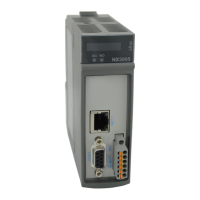6. REDUNDANCY WITH NX3030 CPU
Redundant CPU General Features
Redundant data synchroniza-
tion
Each MainTask cycle, the Active CPU copies redundant data
to the Inactive CPU through the synchronism channels NETA
and NETB. Non-redundant data are not synchronized.
Redundant forcing list syn-
chronization
Each MainTask cycle, the Active CPU copies the redundant
forcing list to the Inactive CPU through the synchronism
channels NETA and NETB. This list includes only forced
redundant variables, this way PLCA and PLCB can have dif-
ferent non-redundant data groups forced, as these variables
are not synchronized.
Single project for PLCA and
PLCB
There’s a single project for the PLCA and PLCB, generated
by MasterTool. The project is composed by the applica-
tion project (executable code) and the archive project (source
code).
CPU identification
Through MasterTool, a NX3030 CPU identifies itself as
PLCA, PLCB or non-redundant CPU. This identification
isn’t part of the application project generated by MasterTool,
even though is written in a CPU using MasterTool. The CPU
identification allows the feature of a single project for PLCA
and PLCB.
Automatic project synchro-
nization
If the Active CPU project becomes different from the Inac-
tive CPU, it is copied from the first to the second. This syn-
chronization can take several MainTask cycles. One must
remember the project is composed by the application project
(executable code) and the archive project (source code), and
both are synchronized. This synchronization can be disabled
in special cases in order to allow visualization of project
modifications which can only be downloaded offline in non-
redundant CPUs.
Online expansion of modules
and PROFIBUS remotes
There are project modifications that can’t be done online in
a non-redundant CPU, such as the inclusion of new modules
or PROFIBUS remotes. However, using the CPU and the
PROFIBUS network redundancy, it was defined a procedure
to accomplish this goal, very important for systems which
need high availability.
Private IP addresses for
PLCA and PLCB
It’s possible to connect to a specific CPU (PLCA or PLCB)
using a private IP address, to obtain half-cluster specific di-
agnostics, for instance. The PLCA IP address will always be
associated to the PLCA NET(i) interface, while the PLCB IP
address will always be associated to the PLCB NET(i) inter-
face.
Active IP
Name of a strategy that allows the Ethernet client connect to
a server from the redundant CPU using always the same IP
address. This prevents the necessity of complex scripts to
change the IP address when switchovers occur due to redun-
dancy. The Active IP address will always be associated to the
NET(i) interface from the Active CPU.
NIC Teaming
Name of the strategy which allows two Ethernet interfaces
from a half-cluster to form a redundant pair sharing a same
IP address. This way, redundant Ethernet network can be
built easily, without the need for the clients, connected to
a NIC Teaming, to implement complex scripts to switch IP
addresses.
277

